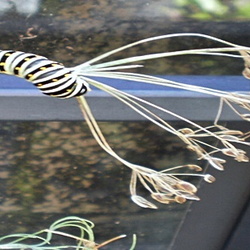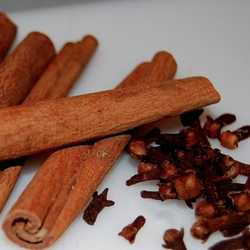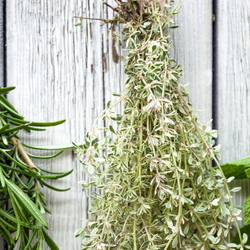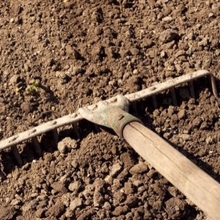A Visit to Beagle Ridge Herb Farm
 I fell in love with Beagle Ridge Herb Farm the minute I pulled into their parking lot. It was beautifully landscaped, smelled wonderful, and most of the herbs I wanted to grow were there waving for me to come on in! The owner, Ellen Reynolds, was a walking-talking garden encyclopedia with helpful tips and suggestions about planting and growing the herbs featured on the farm, along with some that were not. I fell in love with Beagle Ridge Herb Farm the minute I pulled into their parking lot. It was beautifully landscaped, smelled wonderful, and most of the herbs I wanted to grow were there waving for me to come on in! The owner, Ellen Reynolds, was a walking-talking garden encyclopedia with helpful tips and suggestions about planting and growing the herbs featured on the farm, along with some that were not.
Read more about Ellen Reynolds in the sidebar at right.
Ellen said the herbs I was trying to grow would do much better in poor soil, instead of the composted garden loam. She pointed out the herb beds at the farm were not just mulched with gravel, but planted in a 4- to 6-inch layer of "dirty rock" (also known as crusher run, or fines), with stones no bigger than a thumbnail. They used no soil, no additives, no fertilizer, no irrigation (after plants were established), and weeding was made much easier for the few that would grow.
The only prep work that had been done was to mow the existing grass as low as possible, add 6 to 8 pages of moistened newspaper, then a limestone rock (preferred over granite which packs) was spread over the area. Some of their plants had been growing in the alkaline stone base since 2000, the year before they opened the herb farm to the public.
 Ellen explained that she was, "trying to replicate the way they [the herbs] grow in nature. Most Mediterranean herbs grow naturally in rocky wind swept areas so why should we plant them in nutrient rich soil? [. . .] low nutrient soil makes the herbs 'struggle' and they will respond with stronger essential oil production and better flavor." [1] Ellen explained that she was, "trying to replicate the way they [the herbs] grow in nature. Most Mediterranean herbs grow naturally in rocky wind swept areas so why should we plant them in nutrient rich soil? [. . .] low nutrient soil makes the herbs 'struggle' and they will respond with stronger essential oil production and better flavor." [1]
The stone acts as a heat sink, keeping the plants warm, have a faster growth rate, and come back quicker in the spring. She also said, "the rocks will give you a microclimate which will allow you to stretch the boundaries of your hardiness zone and try plants which normally cannot take our cold winters." [1]
Ellen claims her rock-grown herbs are more fragrant, have stronger flavor, and are much healthier with fewer fungal problems, too! Her reasoning explains the weird smelling and tasting herbs grown in my garden.
What is the Mediterranean Climate?
 I was impressed and excited with the visit to Beagle Ridge, and curious about the Mediterranean climate and environment. Before I planted my new herbs in a box of rocks, I did more research to confirm Ellen's claims. I was impressed and excited with the visit to Beagle Ridge, and curious about the Mediterranean climate and environment. Before I planted my new herbs in a box of rocks, I did more research to confirm Ellen's claims.
The Mediterranean Basin has a very unique climate found in only a few places in the world. It is sunny, hot, and dry in the summer, with cold and wet winters. The soil is poor, dry, sandy, rocky, chalky (alkaline), hilly, and quick draining. Similar climates exist in the western United States (California), portions of southwestern Australia, central South America (Chile), and southern tip of South Africa. All of these Mediterranean-type climate zones occur near both the 40° latitudes in the Northern and Southern hemispheres of the planet (click on the map to see a larger version). They are coastal areas bordered by desserts, and mountainous terrain. [2]
The native Mediterranean herbs listed in the sidebar at right have varying shades of gray-green foliage with strong medicinal and culinary uses. They are very aromatic, sun-loving, drought tolerant, and perfect xeriscaping plants!
My Herbs Like Rocks

We have an alley between two buildings facing north-to-south, that receive more than six hours of sun per day, and is fairly protected from the stronger westerly winds. We plan to trellis raspberries and blackberries in beds along the walls, with a gravel pathway running through the length of the area.
We thought the berry bed walkway would be a good place to experiment with the Mediterranean herbs since we were using a stone path. The gravel we received was a bit more coarse and not as "dirty" as Ellen recommended. So we added a bit of greensand along with the potting soil the herbs came in, and some smaller river pebbles to help support them a little better.
We planted a few taller herbs, like bronze fennel, sage, and a couple varieties of chives, in a wide spot along one berry bed. There are large areas of gravel on either end of the path where we planted shrub-like herbs, a young lavender (Lavandula x intermedia 'Grosso') and a transplanted older rosemary (Rosmarinus officinalis) from a friend. We liked the looks of the river pebbles so much that we plan to add a top layer over the entire gravel pathway this year.
The herbs, various thymes and oreganos, grew very well this past summer and have survived the winter weather so far. We look forward to spring to see a revival of growth and to finish up the berry trellises. It is the most peaceful, relaxing, and enjoyable section of our yard.
Try planting a few Mediterranean herbs in rocks to see if they do better for you!
Endnotes:
[1] Beverly A Walker, "Interview with Ellen Reynolds of Beagle Ridge" 5 Oct 2008
[2] Wikipedia contributors, "Mediterranean climate," Wikipedia,
en.wikipedia.org/wiki/Mediterranean_climate&oldid=266701465 (28 Jan 2009)
|
Ellen Reynolds:
- 20 years growing herbs & perennials;
- 15 years of horticulture programs at Reynolda Gardens of Wake Forest University, NC;
- Degree in Education and voted "Virginia Educator of the Year" in 2006;
- National Flower Show Judge;
- Master Gardener;
- Master Naturalist,
Ellen is " [. . . ] just a horticultural addict always trying to push the envelope and trying new plants." [1]
Mediterranean
Herbs
This is a list of Mediterranean herbs you may find easy to grow in rock planting beds, with the xeriscape properties already mentioned:
- Agastaches
- Anise
- Basil
- Bay
- Bee Balm
- Borage
- Caraway
- Catnip
- Chamomile
- Chives
- Coriander/Cilantro
- Cumin
- Dill
- Dittany of Crete
- Fennel
- Horehound, white
- Lavender
- Lemon Balm
- Marjoram
- Olive
- Oregano
- Oyster Plant/Salsify
- Parsley
- Purslane
- Rosemary
- Rue, Common
- Saffron
- Sage
- Salad Burnet
- Santolina
- Savory, Winter
- Sumac
- Tarragon
- Thyme
- Yarrow
|
 I fell in love with
I fell in love with  Ellen explained that she was, "trying to replicate the way they [the herbs] grow in nature. Most Mediterranean herbs grow naturally in rocky wind swept areas so why should we plant them in nutrient rich soil? [. . .] low nutrient soil makes the herbs 'struggle' and they will respond with stronger essential oil production and better flavor." [1]
Ellen explained that she was, "trying to replicate the way they [the herbs] grow in nature. Most Mediterranean herbs grow naturally in rocky wind swept areas so why should we plant them in nutrient rich soil? [. . .] low nutrient soil makes the herbs 'struggle' and they will respond with stronger essential oil production and better flavor." [1]

















